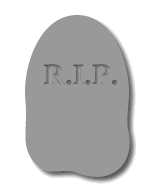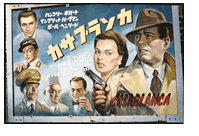Know your screenwriters. Paul Haggis is an interesting and complex character; he is a screenwriter. His credits span from Walker, Texas Ranger to the Oscar nominated screenplay for Million Dollar Baby to the Oscar winning screenplay for Crash. He was a writer on Casino Royale, the first James Bond reboot, and its follow up Quantum of Solace. He is one of the few important Hollywood figures to publicly renounce Scientology. You can read his interesting bio here, and/or listen to him discuss screenwriting in this interview….
Category: People
Death Race
This from Variety.com:
Charles B. Griffith, known for melding black humor in his screenplays for Roger Corman including “Little Shop of Horrors,” died Sept. 28 in San Diego. He was 77.
Griffith, to whom Quentin Tarantino dedicated his recent film “Death Proof,” also wrote exploitation classics including “Death Race 2000,” directed by Paul Bartel“Eat My Dust,” starring Ron Howard, which Griffith also directed. and
“Little Shop of Horrors” later became a musical by Alan Menken and Howard Ashman, which was then made into a feature directed by Frank Oz.
Griffith’s grandmother Myrtle Vail was a vaudevillian who created one of radio’s earliest soap operas, “Myrt & Marge.” Born in Chicago, he came to Hollywood to help Vail break into television. After an actor friend introduced him to Corman, he received his first feature writing credit on Corman’s “It Conquered the World.”
He went on to write screenplays for sci-fi, girlie and action pics including “Gunslinger,” “Naked Paradise,” “Attack of the Crab Monsters,” “Bucket of Blood,”“Forbidden Island” and “Beast from Haunted Cave,” directed by Monte Hellman. “Teenage Doll,” “Rock All Night,”
Griffith played a centrol role in 1960s and ’70s film and pop culture — his motorcycle pics “The Wild Angels,” starring Peter Fonda, and “The Devil’s Angels,” with John Cassavetes, served as forerunners to “Easy Rider,” and his original script for psychedelic fable “The Trip” was rejected by Corman rejected for glorifying drugs, leaving Jack Nicholson to write the final version. He also contributed uncredited scenes to Roger Vadim‘s “Barbarella.”
Griffith retired in the 1980s to write books, travel and cook.
He is survived by his wife Marmory, a daughter and four grandchildren.
KURT VONNEGUT (1922-2007)
In his book Bagombo Snuff Box: Uncollected Short Fiction, Kurt Vonnegut offered the following advice on writing:
1. Use the time of a total stranger in such a way that he or she will not feel the time was wasted.
2. Give the reader at least one character he or she can root for.
3. Every character should want something, even if it is only a glass of water.
4. Every sentence must do one of two things — reveal character or advance the action.
5. Start as close to the end as possible.
6. Be a sadist. No matter how sweet and innocent your leading characters, make awful things happen to them — in order that the reader may see what they are made of.
7. Write to please just one person. If you open a window and make love to the world, so to speak, your story will get pneumonia.
8. Give your readers as much information as possible as soon as possible. To heck with suspense. Readers should have such complete understanding of what is going on, where and why, that they could finish the story themselves, should cockroaches eat the last few pages.
Goodbye, Mr. Vonnegut….
WHO ARE THESE PEOPLE?
Bruce Joel Rubin
Alfred Uhry
Christopher Hampton
Mark Peploe
Bernardo Bertolucci
John Patrick Shanley
Ruth Prawer Jhabvala
Kurt Luedtke
Earl W. Wallace
Peter Shaffer
Robert Benton
John Briley
Ernest Thompson
Colin Welland
Alvin Sargent
Bo Goldman
Steve Tesich
Nancy Dowd
Waldo Salt
Robert C. Jones
Alvin Sargent
Marshall Brickman
Lawrence Hauben
Frank Pierson
William Peter Blatty
David S. Ward
Jeremy Larner
Ernest Tidyman
Edmund H. North
James Goldman
Stirling Silliphant
William Rose
Robert Bolt
Claude Lelouch
Frederic Raphael
Edward Anhalt
S. H. Barnett
John Osborne
James R. Webb
Abby Mann
William Inge
Richard Brooks
Neil Paterson
Nedrick Young
Harold Jacob Smith
George Wells
ON THE SHOULDERS OF GIANTS
 If you wanted to be a rock superstar, you would know a great deal about a great many musicians who preceded you – and their work would profoundly influence yours. If you wanted to be a top athlete – same thing. But when it comes to wanting to be an A-list screenwriter, many emerging writers have very little knowledge of our own important tradition. We stand on the shoulders of giants and knowing the work of these giants, inside and out, is an enormous advantage. Understanding their approaches and techniques gives you tools you might otherwise never develop.
If you wanted to be a rock superstar, you would know a great deal about a great many musicians who preceded you – and their work would profoundly influence yours. If you wanted to be a top athlete – same thing. But when it comes to wanting to be an A-list screenwriter, many emerging writers have very little knowledge of our own important tradition. We stand on the shoulders of giants and knowing the work of these giants, inside and out, is an enormous advantage. Understanding their approaches and techniques gives you tools you might otherwise never develop.
So who are these giants?
The WGA has a list of the top 101 screenplays. Look at the writers of these screenplays. Get to know them.
AskMen.com has a top ten list of legendary screenwriters. The author (whom I initially mis-identified as the scriboshpere’s own Craig Mazin, but see below) includes background on each writer. See how many of them you never heard of.
The book Framework: A History of Screenwriting In The American Film is an excellent resource for learning about the giants.
Many of the screenplays of these giants are freely downloadable online. Download them; read them. Learn and enjoy….
OPB (Other People’s Blogs)
I received emails from a couple new bloggers recently letting me know they exist. Thought I’d pass it on to you….
Ken Levine, tv comedy writer/director with credits including M*A*S*H, Simpsons, Becker and Everybody Loves Raymond has a new blog called “by Ken Livine”.
Xander Bennett, a TV writer from Australia, also has an interesting new blog, Chained To The Keyboard.
TWO FOR THE ROAD
ONE: If you haven’t already checked out the Artful Writer’s thoughtful discussion of mentor characters (as opposed to real live mentors), you should.
TWO: Michael Chabon is an excellent writer and screenwriter. Here is his very interesting blog.
WHAT A WRITER CAN BE
Writing need not be vacuous. Example.